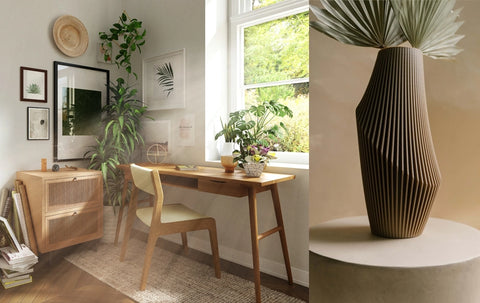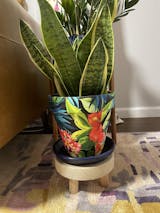 Hello, beautiful human!
Hello, beautiful human!
My name is Alisa, pattern designer and creator of Alisa Textile - an European Home Decor brand, creating textiles that provide positive emotional response.
Today I’m taking over Woodland Pulse’s blog, and will be sharing my thoughts on the Mix of Geometric and Organic shapes in Interior Design.
How did I choose this topic? I can’t stand boring living spaces, but more importantly my mission is to help you establish a healthy, stress free environment. A home.
Let’s start with…
The Importance of Shape in Interior Design

The enchanting world of interior design begins with the artful use of shapes. Combining various forms can guide the spectator through a variety of emotions, ignite intriguing thoughts, and paint vibrant perceptions, all of which have the power to shape our behavior and mental state.
By harnessing the deep influence of shapes and forms, we can craft spaces that resonate immensely and leave a meaningful impact on us and all who encounter them.
This article focuses on the magic of mixing and matching geometric and organic shapes in our homes with the intent to help you create an engaging living space.
First thing first - a quick definition of geometric and organic shapes in interior design emphasizing their individual psychological effect.
Geometric shapes

Geometric doesn’t mean boring! Check out this stunning vase from Woodland Pulse. The clear lines provide a sense of structured motion, while its asymmetry sparks interest and makes the design a beautiful focal point for each living space.
In interior design, geometric shape refers to a structured and well-defined form characterized by clear lines and angles. These shapes include geometric figures such as squares, rectangles, circles, triangles, and polygons.
| Geometric shapes are often used to create a sense of order, symmetry, and visual interest within a space, as they can provide a sense of reliability, security and predictability.
|
Organic shapes
 Embracing color in interior design makes it possible to personalize your environment even more and its effect on our subconscious is a vital variable in creating an accomplished living space. Alisa Textile’s “In Bloom” Throw Pillow Cover mirrors the beauty of nature right into your living space. It will raise the energy levels and provide the viewer a daily dose of positivity.
Embracing color in interior design makes it possible to personalize your environment even more and its effect on our subconscious is a vital variable in creating an accomplished living space. Alisa Textile’s “In Bloom” Throw Pillow Cover mirrors the beauty of nature right into your living space. It will raise the energy levels and provide the viewer a daily dose of positivity.
In interior design, an organic shape refers to a naturally occurring form, often inspired by patterns we see in nature. These shapes typically lack distinct, sharp angles and feature smooth, flowing contours. They introduce a sense of fluidity, softness, and a more relaxed, natural feel to a space.
|
Incorporating organic shapes in interior design can create a harmonious contrast with more structured and geometric elements, contributing to a dynamic and visually appealing design scheme.
|
Here is a quick overview of this article's main points:
- Incorporating geometric shapes in interior design - psychology and tips.
- Incorporating organic shapes in interior design - psychology and tips.
- The synergy between geometric and organic shapes- Achieving balance in design
- Practical tips for combining these shapes effectively
Incorporating Geometric Shapes in Interior Design - Psychology & Tips

In the captivating world of interior design, an array of geometric shapes, including squares, rectangles, triangles, circles, and ovals, play a pivotal role in shaping the aesthetics and emotions of a space. From the initial conception of floor plans and layouts to the selection of furniture and decor, these geometric forms hold the power to transform your environment in remarkable ways.
Squares and rectangles, with their clean, straight lines, are emissaries of order and structure. They bestow a sense of stability and predictability upon a room, enveloping its inhabitants in a comforting embrace of security.
Triangular elements, on the other hand, introduce an element of dynamism and direction. They infuse spaces with a palpable aura of movement, fostering an atmosphere of intrigue and excitement, as though the room itself is embarking on an exciting journey.
Circles and ovals, characterized by their gentle, curved contours, evoke a sense of protection and unity. Shapes without harsh angles instill an innate sense of cohesion and safety, adding a graceful flow to your surroundings.
| Essentially, the choice and combination of these common geometric shapes in your interior design allow you to craft an environment that resonates with your desired emotions, imprinting each space with its unique character and charm. |
Tips for incorporating geometric forms in your interior design project:
- The artful application of form and shape extends beyond aesthetics to encompass a profound influence on our health and well-being. Extensive research has unveiled the transformative power of specific shapes and forms in positively shaping our mental and physical states.
- The clean, unyielding lines of straight forms provide focus and concentration. These geometric elements channel our attention and sharpen our senses, providing the mental clarity needed for heightened productivity and concentration, which makes them very suitable for our working space or kitchen.
- The gentle embrace of curved shapes possesses the remarkable ability to induce relaxation and tranquility. These flowing contours can alter the mind and spirit into a soothing state, fostering a sense of calm that nurtures well-being. This makes them a key player in our bedroom or our living room.
By delving into the intricate interplay between form, shape, and their impact on health and well-being, we hold the key to crafting spaces that not only exude visual appeal but also serve as sanctuaries of vitality and balance.
Incorporating Organic Shapes in Interior Design - Psychology & Tips

The presence of organic shapes is a powerful force in shaping the ambience and emotions of a space. Most commonly used in the selection of furniture and decor, organic forms possess the transformative ability to breathe life and character into your surroundings.
Organic shapes, by their very nature, bring a sense of freeform artistry to interior design. Their fluid, irregular contours mirror the beauty found in the natural world, filling up each space with a unique sense of vibrancy and vitality.
Incorporating organic shapes into interior design is a powerful tool to harness the psychology of space and enhance the overall ambience of a room. A space will take on an inviting, harmonious aura when organic shapes inspired by the flowing contours of the natural world come into play. Such shapes have a profound impact on our emotional and psychological well-being. Organic shapes foster a sense of unity and connection with the environment, offering protection and reassurance through their absence of sharp edges and angles. They infuse an effortless flow into the space, encouraging occupants to navigate their surroundings with a sense of ease and comfort.
In essence, the selection and harmonious integration of organic shapes in your interior design is a creative journey, allowing you to craft an environment that resonates with your desired emotions and reflects the natural beauty and vitality of the world around you.
Tips for incorporating organic forms in your interior design project:
- Balance is a key factor when working with organic shapes. These forms should complement the overall design and layout, striking a harmonious equilibrium with other design elements. Use them sparingly to avoid overwhelming the space.
- Incorporate curved lines and soft, irregular forms in areas where relaxation and comfort are desired, such as bedrooms and living rooms.
- Organic shapes naturally encourage a sense of flow and movement. Use them to guide the eye and create a seamless transition between different areas or spaces within the home.
- Consider using multiple materials with organic textures and patterns - wood, stone, or textiles. Such a mix enhances the connection to nature and reinforces the use of organic shapes.
Incorporate organic shapes that resonate with your personal preferences and style. Whether through artwork, furniture, or decor, infusing your unique touch ensures a more meaningful and inviting environment.
The Synergy Between Geometric Shapes & Organic Shapes - Achieving Balance in Design

The harmonious synergy between organic and geometric shapes is a testament to the artful balance that can be achieved. The interplay of these contrasting elements offers a rich tapestry of visual and emotional experiences within a space.
Organic shapes, inspired by nature's soft and flowing contours, infuse an environment with warmth and a sense of natural vitality. They evoke feelings of tranquility and comfort, inviting occupants to connect with their surroundings on a profound level.
In contrast geometric shapes, with their structured lines and precise angles, bring a sense of order, stability, and architectural precision. They promote focus and clarity, offering a backdrop of structure against which the organic forms can shine.
Together, they create a dynamic dance of opposites, where the softness of curves finds balance with the strictness of lines. As a result, the design not only captivates the eye but also resonates with the soul, crafting spaces that are inviting and intellectually engaging at the same time.
This exquisite fusion of organic and geometric shapes allows for endless creativity, offering surrounding creators the tools to craft interiors that transcend the boundaries of style and function, ultimately delivering an environment that is visually captivating and emotionally enriching at the same time.
Achieving a harmonious balance between geometric and organic shapes in a room is a design feat that can transform your space into a captivating and inviting environment. To strike this equilibrium successfully, consider the following tips:
Begin by selecting a focal point in the room where you can prominently feature either geometric or organic shapes. This will help anchor your design.
- Evenly Distributed Shapes :
Balance the distribution of both types of shapes throughout the space. Avoid clustering them in one area. Instead, disperse them to create visual harmony.
Pay attention to color schemes. Consistent color palettes can help unify the different shapes in the room, creating a cohesive and balanced look.
Experiment with different scales of shapes. Pair larger organic forms with smaller geometric details, or vice versa - creating a pleasing visual diversity.
Keep the room's function in mind. Organic shapes can promote relaxation, making them ideal for bedrooms or living areas, while geometric shapes in home offices can stimulate focus and productivity.
Employ transitional elements like furniture or decor pieces, combining both geometric and organic elements. These can serve as visual bridges between the two shape categories.
- Texture and Material Selection:
Choose textures and materials that complement the shapes in the room. Put emphasis on organic shapes using natural materials and highlight geometric shapes with sleek and polished surfaces.
Experiment with both symmetrical and asymmetrical arrangements. Symmetry can provide a sense of order and structure, while asymmetry can infuse an element of surprise and intrigue.
Introduce depth and dimension by layering shapes. Wall art, rugs, and decor items can add layers that enrich the visual experience.
Don't forget to infuse your personal style into the design. Your unique preferences can guide the balance of shapes, creating a room that resonates with your individuality. Balancing geometric and organic shapes in interior design requires a creative eye and a thoughtful approach.
By implementing these tips, you can craft a space that is not only aesthetically pleasing to the eye but also feels harmonious and inviting, ensuring a delightful and balanced room that resonates with both your style and the functionality of the space.
Thank you for being here and taking the time to read this article!
Have an amazing day!
Love,
Alisa
Want to go on a colorful journey? Visit www.alisatextile.com or give us a follow @alisatextile on Instagram.
PHOTOCREDITS: vecteezy.com / unsplash.com


 Hello, beautiful human!
Hello, beautiful human!









